Abstract
A mechanism is proposed for generating one parental and one recombinant genome in a single recombination event between two DNA molecules. Three stages of the event are described: initiation, replication, and return. Initiation requires breakage and joining of strands. Replication proceeds through a biparental “replication fork” generated in initiation. Return also involves breakage and joining of strands. Some of the implications of such a mechanism for genetic recombination are discussed.
Full text
PDF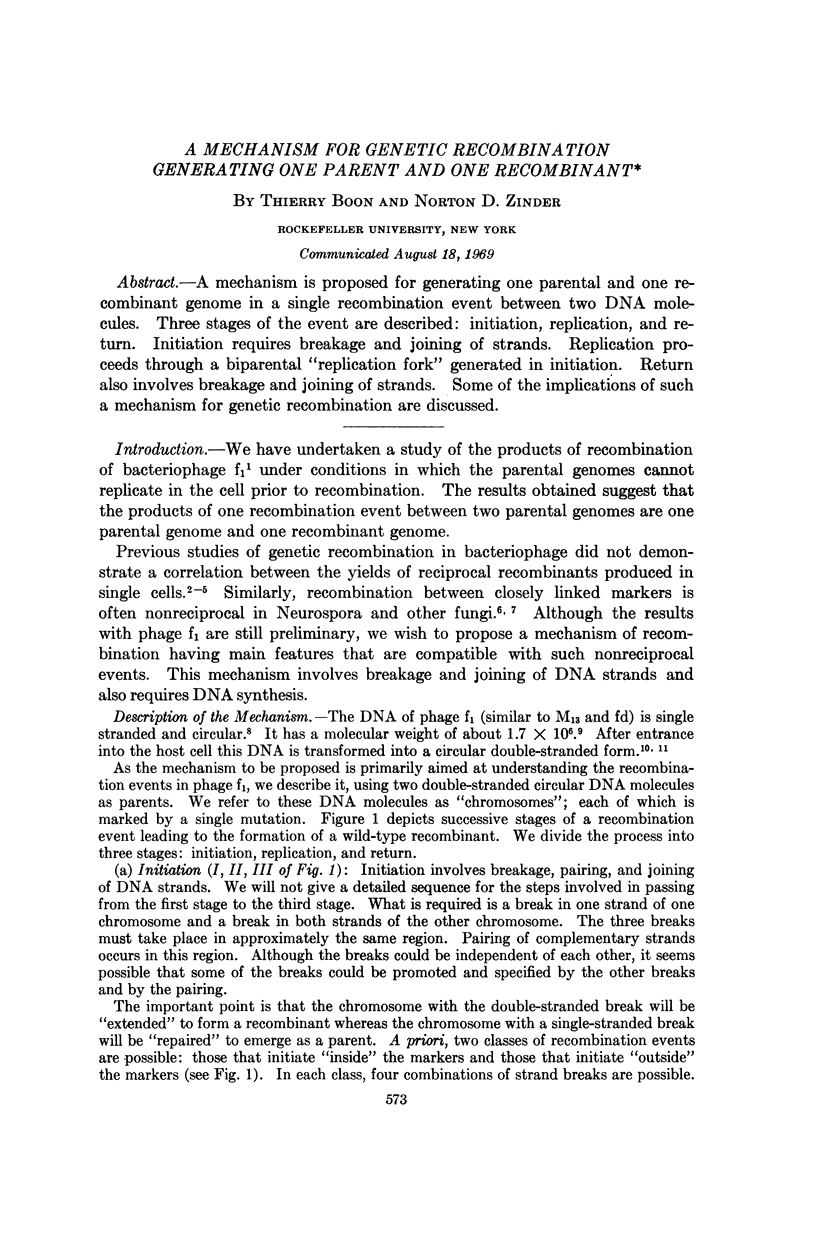
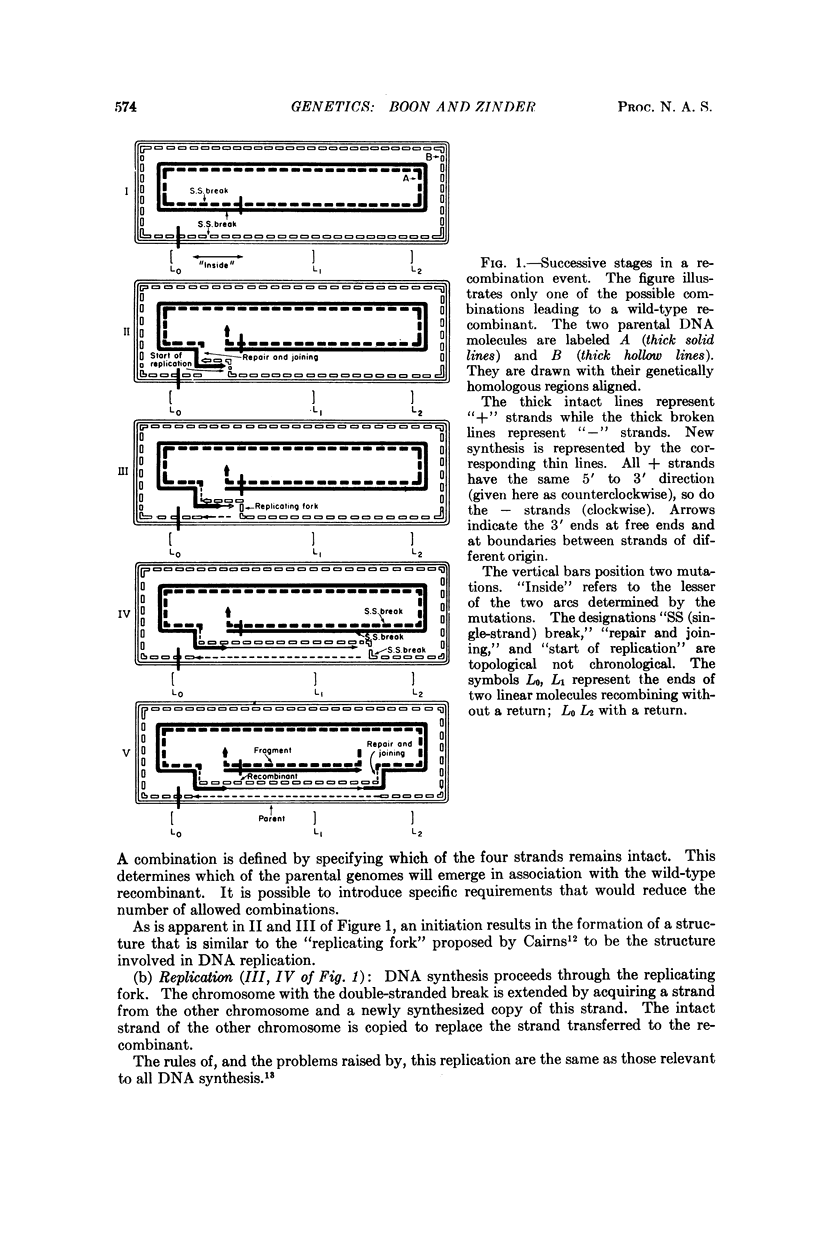
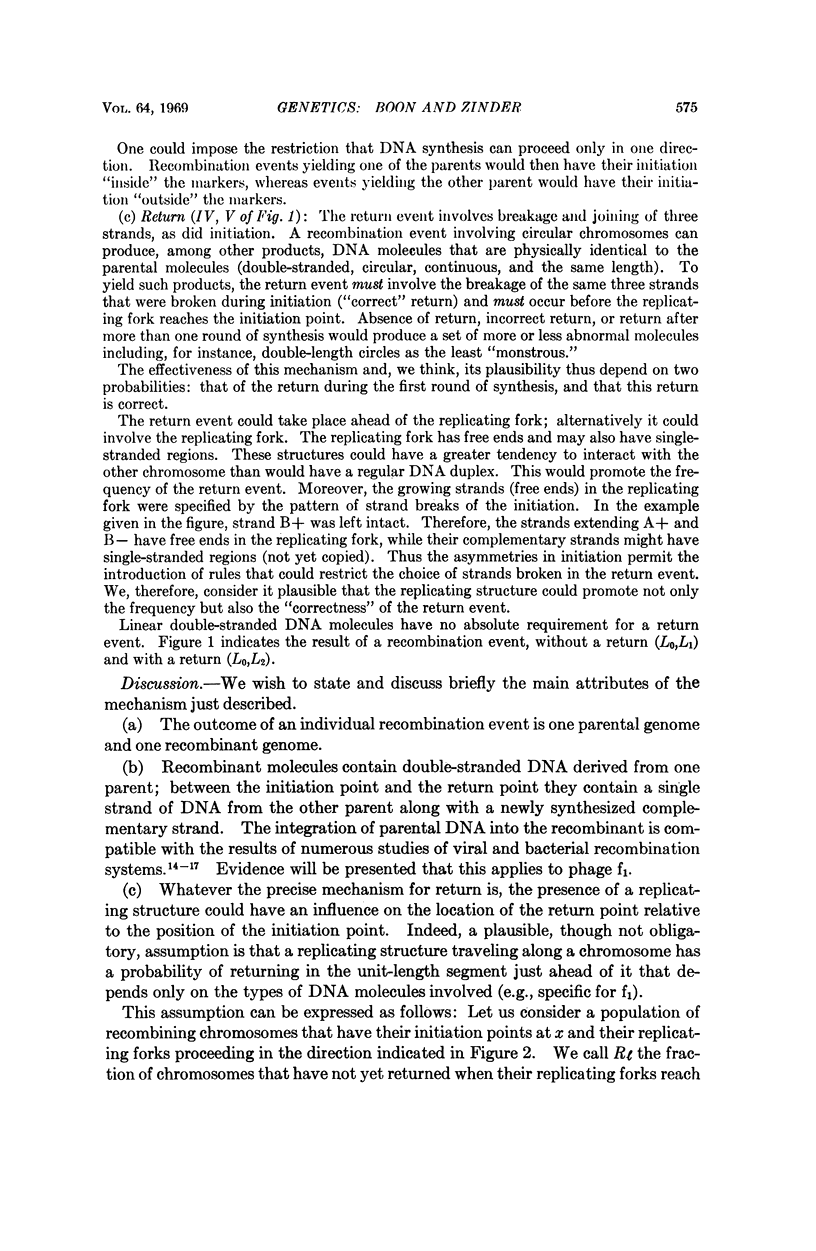
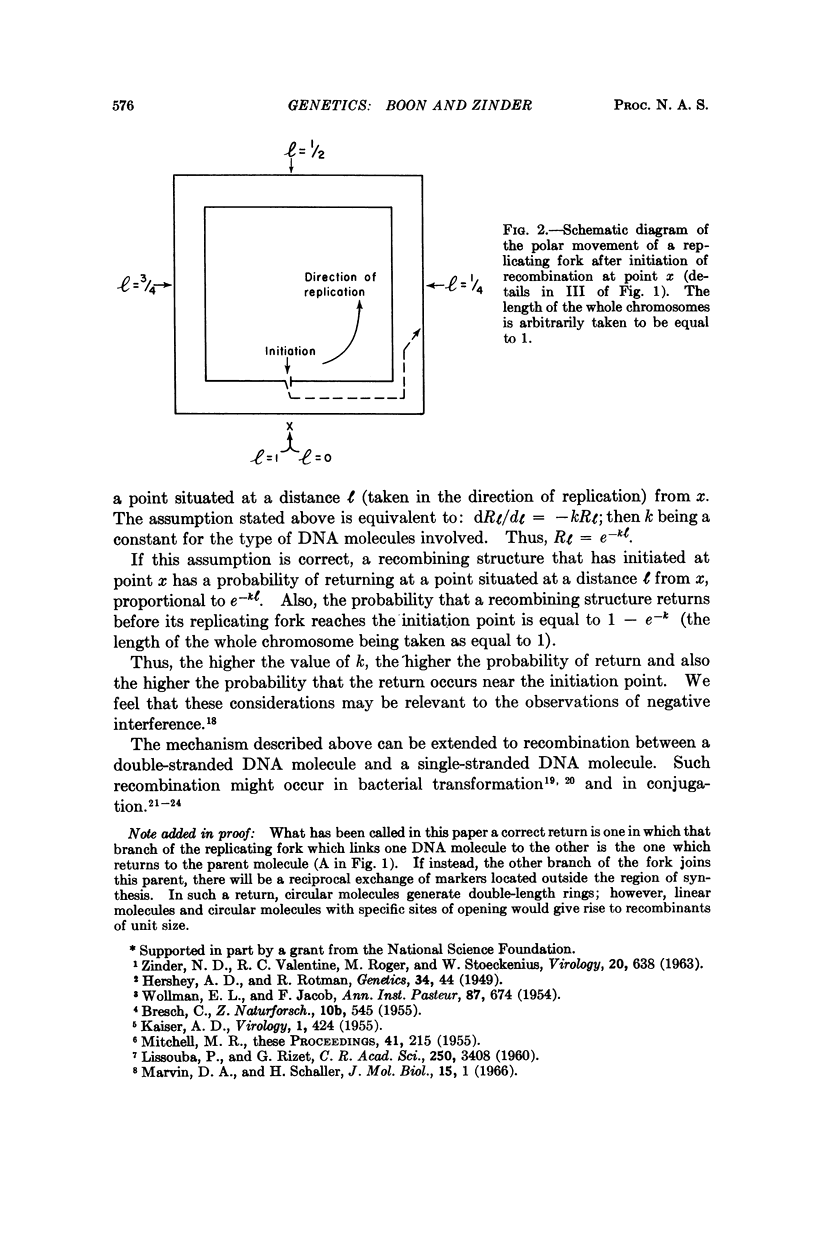
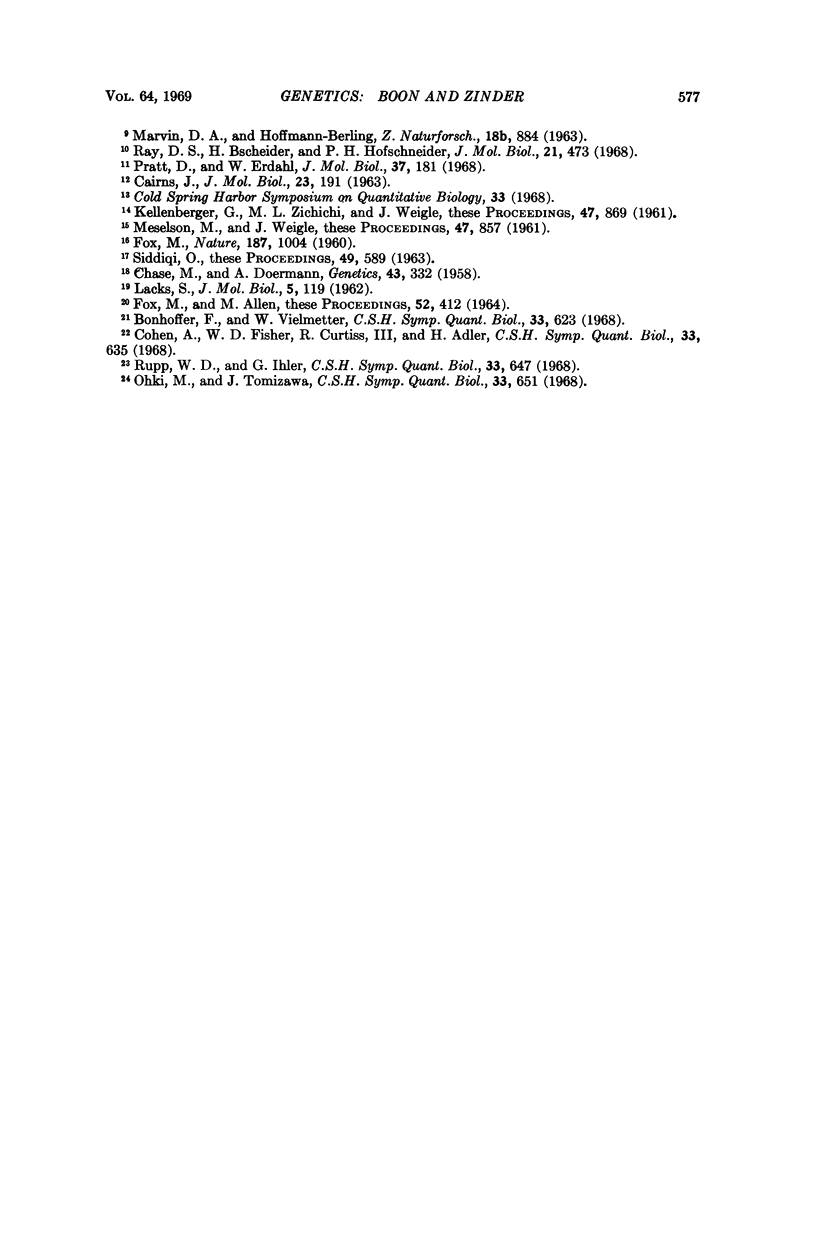
Selected References
These references are in PubMed. This may not be the complete list of references from this article.
- Bonhoeffer F., Vielmetter W. Conjugational DNA transfer in Escherichia coli. Cold Spring Harb Symp Quant Biol. 1968;33:623–627. doi: 10.1101/sqb.1968.033.01.069. [DOI] [PubMed] [Google Scholar]
- Chase M, Doermann A H. High Negative Interference over Short Segments of the Genetic Structure of Bacteriophage T4. Genetics. 1958 May;43(3):332–353. doi: 10.1093/genetics/43.3.332. [DOI] [PMC free article] [PubMed] [Google Scholar]
- Cohen A., Fisher W. D., Curtiss R., 3rd, Adler H. I. The properties of DNA transferred to minicells during conjugation. Cold Spring Harb Symp Quant Biol. 1968;33:635–641. doi: 10.1101/sqb.1968.033.01.071. [DOI] [PubMed] [Google Scholar]
- FOX M. S., ALLEN M. K. ON THE MECHANISM OF DEOXYRIBONUCLEATE INTEGRATION IN PNEUMOCOCCAL TRANSFORMATION. Proc Natl Acad Sci U S A. 1964 Aug;52:412–419. doi: 10.1073/pnas.52.2.412. [DOI] [PMC free article] [PubMed] [Google Scholar]
- Hershey A. D., Rotman R. Genetic Recombination between Host-Range and Plaque-Type Mutants of Bacteriophage in Single Bacterial Cells. Genetics. 1949 Jan;34(1):44–71. doi: 10.1093/genetics/34.1.44. [DOI] [PMC free article] [PubMed] [Google Scholar]
- KAISER A. D. A genetic study of the temperate coliphage. Virology. 1955 Nov;1(4):424–443. doi: 10.1016/0042-6822(55)90036-2. [DOI] [PubMed] [Google Scholar]
- KELLENBERGER G., ZICHICHI M. L., WEIGLE J. J. Exchange of DNA in the recombination of bacteriophage lambda. Proc Natl Acad Sci U S A. 1961 Jun 15;47:869–878. doi: 10.1073/pnas.47.6.869. [DOI] [PMC free article] [PubMed] [Google Scholar]
- LACKS S. Molecular fate of DNA in genetic transformation of Pneumococcus. J Mol Biol. 1962 Jul;5:119–131. doi: 10.1016/s0022-2836(62)80067-9. [DOI] [PubMed] [Google Scholar]
- LISSOUBA P., RIZET G. [On the existence of a polarized genetic unit which does not undergo non-reciprocal exchanges]. C R Hebd Seances Acad Sci. 1960 May 16;250:3408–3410. [PubMed] [Google Scholar]
- MARVIN D. A., HOFFMANN-BERLING H. A FIBROUS DNA PHAGE (FD) AND A SPHERICAL RNA PHAGE (FR) SPECIFIC FOR MALE STRAINS OF E COLI. II. PHYSICAL CHARACTERISTICS. Z Naturforsch B. 1963 Nov;18:884–893. doi: 10.1515/znb-1963-1106. [DOI] [PubMed] [Google Scholar]
- MESELSON M., WEIGLE J. J. Chromosome brekage accompanying genetic recombination in bacteriophage. Proc Natl Acad Sci U S A. 1961 Jun 15;47:857–868. doi: 10.1073/pnas.47.6.857. [DOI] [PMC free article] [PubMed] [Google Scholar]
- Marvin D. A., Schaller H. The topology of DNA from the small filamentous bacteriophage fd. J Mol Biol. 1966 Jan;15(1):1–7. doi: 10.1016/s0022-2836(66)80204-8. [DOI] [PubMed] [Google Scholar]
- Mitchell M. B. ABERRANT RECOMBINATION OF PYRIDOXINE MUTANTS OF Neurospora. Proc Natl Acad Sci U S A. 1955 Apr 15;41(4):215–220. doi: 10.1073/pnas.41.4.215. [DOI] [PMC free article] [PubMed] [Google Scholar]
- Ohki M., Tomizawa J. Asymmetric transfer of DNA strands in bacterial conjugation. Cold Spring Harb Symp Quant Biol. 1968;33:651–658. doi: 10.1101/sqb.1968.033.01.074. [DOI] [PubMed] [Google Scholar]
- Pratt D., Erdahl W. S. Genetic control of bacteriophage M13 DNA synthesis. J Mol Biol. 1968 Oct 14;37(1):181–200. doi: 10.1016/0022-2836(68)90082-x. [DOI] [PubMed] [Google Scholar]
- Rupp W. D., Ihler G. Strand selection during bacterial mating. Cold Spring Harb Symp Quant Biol. 1968;33:647–650. doi: 10.1101/sqb.1968.033.01.073. [DOI] [PubMed] [Google Scholar]
- Siddiqi O. H. INCORPORATION OF PARENTAL DNA INTO GENETIC RECOMBINANTS OF E. COLI. Proc Natl Acad Sci U S A. 1963 May;49(5):589–592. doi: 10.1073/pnas.49.5.589. [DOI] [PMC free article] [PubMed] [Google Scholar]
- WOLLMAN E. L., JACOB F. Etude génétique d'un bactériophage tempéré d'Escherichia Coli. II. Mécanisme de la recombinaison génétique. Ann Inst Pasteur (Paris) 1954 Dec;87(6):674–690. [PubMed] [Google Scholar]
- ZINDER N. D., VALENTINE R. C., ROGER M., STOECKENIUS W. F1, A ROD-SHAPED MALE-SPECIFIC BACTERIOPHAGE THAT CONTAINS DNA. Virology. 1963 Aug;20:638–640. doi: 10.1016/0042-6822(63)90290-3. [DOI] [PubMed] [Google Scholar]


